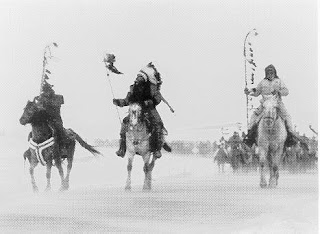
Understanding Lakota Relationships
One of the areas that separate the Lakota and other Indian Tribes from the Non-Indians is the manner in which we claim and call our relatives. This has become more apparent with the birth of my great granddaughter. From the time of her birth she became an important member of my extended family. She was positioned in her proper place according to the generation she was born into. For the rest of her life she will know how she is to refer to her relatives and how they will refer to her. As the newest generation she will be surrounded by the older generations who will love and cherish her.
The following is an explanation regarding the Tiyospaye and how we refer to our relatives. It’s an excerpt from a paper I wrote on “Lakota Social Change” for a class I took at the University of Nebraska.
A Lakota’s relatives are classified according to the generation they belong to and what sex they are. There is no regard to whether they are related through the father’s or mother’s line. The kinship term used in the traditional culture determined one’s behavior toward the person. Parents, grandparents and brothers and sisters were treated with love and respect. One, however showed more restraint around the persons referred to as aunt and uncle.
For example, one would use the same term Ina for their mother and their mother’s sister; Ate would refer to both their father and their father’s brother. Your mother’s brother would be called Lekshi and your father’s sister would be Tonwin – both of these terms are roughly the equivalent of aunt and uncle in American kinship terminology. The terms for sister and brother would be used for siblings and the children of those they called mother and father (i.e. parallel cousins—the children of your maternal aunts and paternal uncles). There were, however different terms for brother and sister depending upon if they were older or younger and what gender the person was, who was speaking. The terms for cousin also depended upon the gender of the person talking.
The way in which Lakota refer to their relatives is often confusing for Non-Indians – for example a Lakota may call someone ‘aunt’ who the Non-Indian would refer to as ‘cousin’. The rule normally is that all of the cousins in the parent’s generation would be aunts and uncles no matter how distant the relationship was. All of the individuals in the generation who are recognized as parents by both the mother and father are called grandparent. There is no term for ‘great aunt’ or ‘great uncle’. (end of excerpt)….
We use a story as an example of how we are sometimes faced with a cultural clash
 when dealing with relationship and the larger society. My oldest son was in a biology class were they were learning about genealogy and was supposed to create a family tree. He listed his father’s aunt as his grandmother and the teacher tried to correct his paper by telling him that she was not his grandmother but his great-aunt. My son was furious with the teacher and told him “I don’t care what you say she is my grandmother!” We experience this constant attempt on the part of Non-Indians to correct us on who is what according to the manner in which Euro-Americans refer to relatives.
when dealing with relationship and the larger society. My oldest son was in a biology class were they were learning about genealogy and was supposed to create a family tree. He listed his father’s aunt as his grandmother and the teacher tried to correct his paper by telling him that she was not his grandmother but his great-aunt. My son was furious with the teacher and told him “I don’t care what you say she is my grandmother!” We experience this constant attempt on the part of Non-Indians to correct us on who is what according to the manner in which Euro-Americans refer to relatives.I find the idea of one of the grandchild of my first cousins who I refer to as a sister being my fourth cousin and not a grandchild severely limits the relationship and as a result puts barriers between me and this grandchild.
This picture is the my daughter and her Grandma Dorothy who the Biology Teacher tried to convence my son was his Great Aunt and not his Grandmother. My great granddaughter is the grandchild of this baby.











